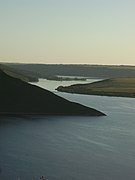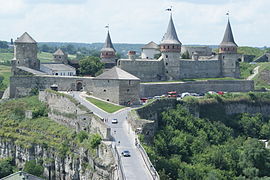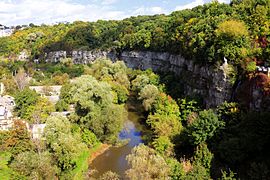Bakota (Ukraine)
Coordinates: 48 ° 35 ′ 35 ″ N , 26 ° 58 ′ 44 ″ E
Bakota ( Ukrainian Бакота ) is an abandoned village near Kamianets -Podilskyj in Khmelnitsky Oblast , Ukraine . The village was 55 km southeast of Kamianets-Podilskyj on the Dniester .
History and legends
Archaeological excavations have shown that on the banks of the Dniester River there were many pagan sanctuaries and burial mounds with women's graves. This points to a settlement in these areas since prehistoric times. There is also a legend of the Buddha's footprint on a stone that is now at the bottom of the Smotrych River .
Bakota is first mentioned in the chronicles of 1024. In the 13th century Bakota was a large city in the principality of Halych-Volodymyr and a political and administrative center of the Lower Dniester. In the 12th century Bakota had an area of about 10 hectares and a population of about 2500 people.
The first mention of the cave monastery appeared in 1362, where it was referred to as "longtime". The founder of the monastery was Antonij, who was also the founder of the Kiev-Pechersk Lavra . In 1255 Mongolian Tatars took over the city. Monks and residents hid in the labyrinth of the cave monastery. The intruders buried the people alive in their hiding place. In 1258 the Tatars destroyed the Bakota Castle. In 1431 Bakota became a neutral border area as a result of an armistice between the Kingdom of Poland and Lithuania . In that year the residents organized an uprising, killed the sovereign and declared their independence. After three years they were the target of a punitive expedition by the Polish army. The houses were burned down, the castle destroyed and the population fled.
After 1918 the city became a border town, a wall was built along the river, as Romanian territory was on the opposite bank of the Dniester . The 1933 famine did not affect Bakota, but the monastery was closed. Another famine after the Second World War in 1947 decimated the population of Bakota considerably, only two thirds of the inhabitants survived. In the 1960s, services in the monastery church were also ended. The icons, crosses and books were destroyed along with the church.
Personalities
- Faina Grigoryevna Melnik (1945–2016), Soviet-Ukrainian discus thrower




